As a nutrition strategy, the keto diet emphasizes high-fat, adequate-protein, and low-carbohydrate intake. Unlike many other diets that focus on calorie restriction, the keto diet aims to induce a metabolic state called ketosis. During ketosis, the body becomes more efficient at burning fat for energy, which can lead to weight loss. By significantly reducing carbohydrate intake and replacing it with fat, the body’s metabolism shifts away from carbs and towards fat and ketones.
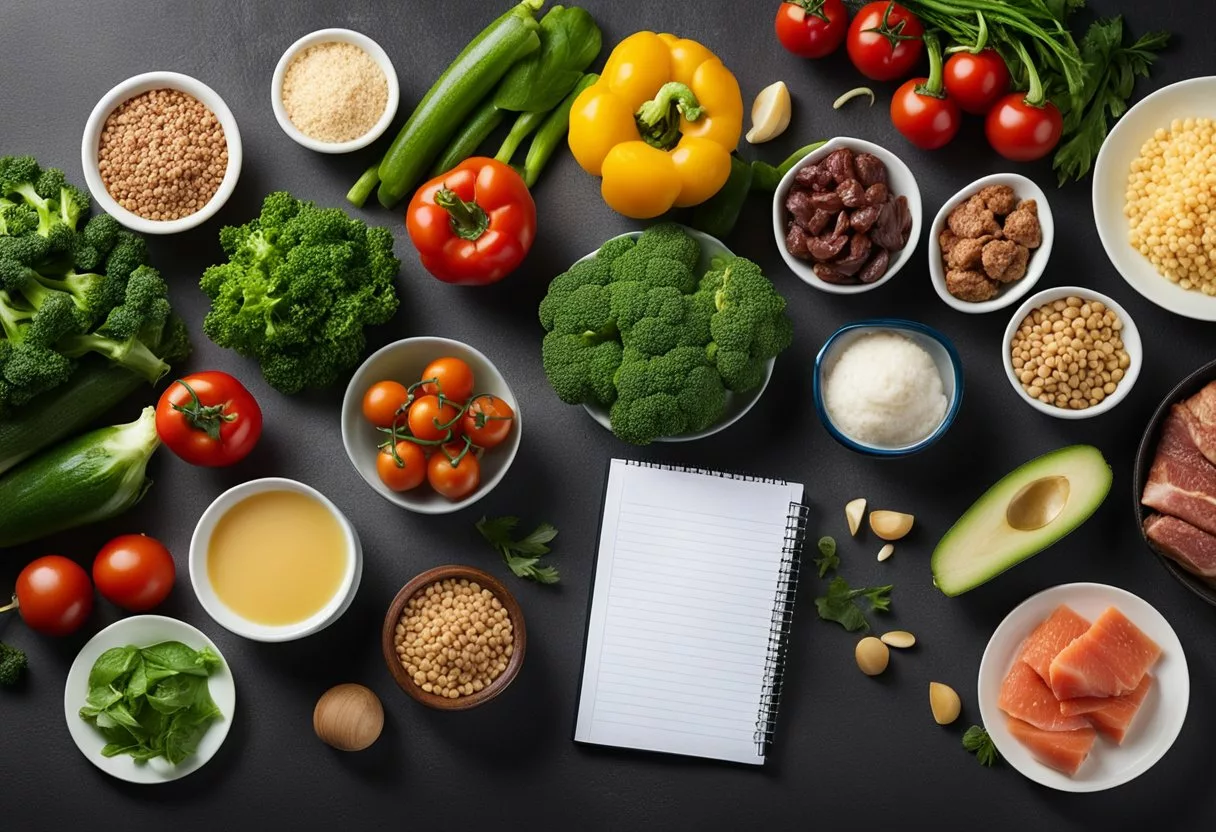
Meal planning is a critical component of the keto diet, especially for individuals pursuing weight loss goals. A well-structured keto meal plan ensures that dieters adhere to the macronutrient ratios needed to maintain ketosis. It also helps to prevent common pitfalls such as nutrient deficiencies or the consumption of inappropriate foods that could halt progress. Planning meals ahead of time can also assist with appetite control, making it easier for individuals to avoid overeating or succumbing to cravings for high-carb foods.
The keto diet’s popularity stems from its potential benefits, which may include rapid weight loss, improved blood sugar management, and a decreased appetite. To achieve these benefits, individuals need to consume healthy fats, moderate amounts of protein, and minimal carbohydrates. Foods typically included in keto meal plans are meats, fish, eggs, dairy with high-fat content, nuts, seeds, and certain low-carb vegetables. Understanding which foods to avoid—such as grains, sugar, and high-carb fruits—is just as crucial for those looking to optimize their keto diet for weight loss.
Understanding Keto
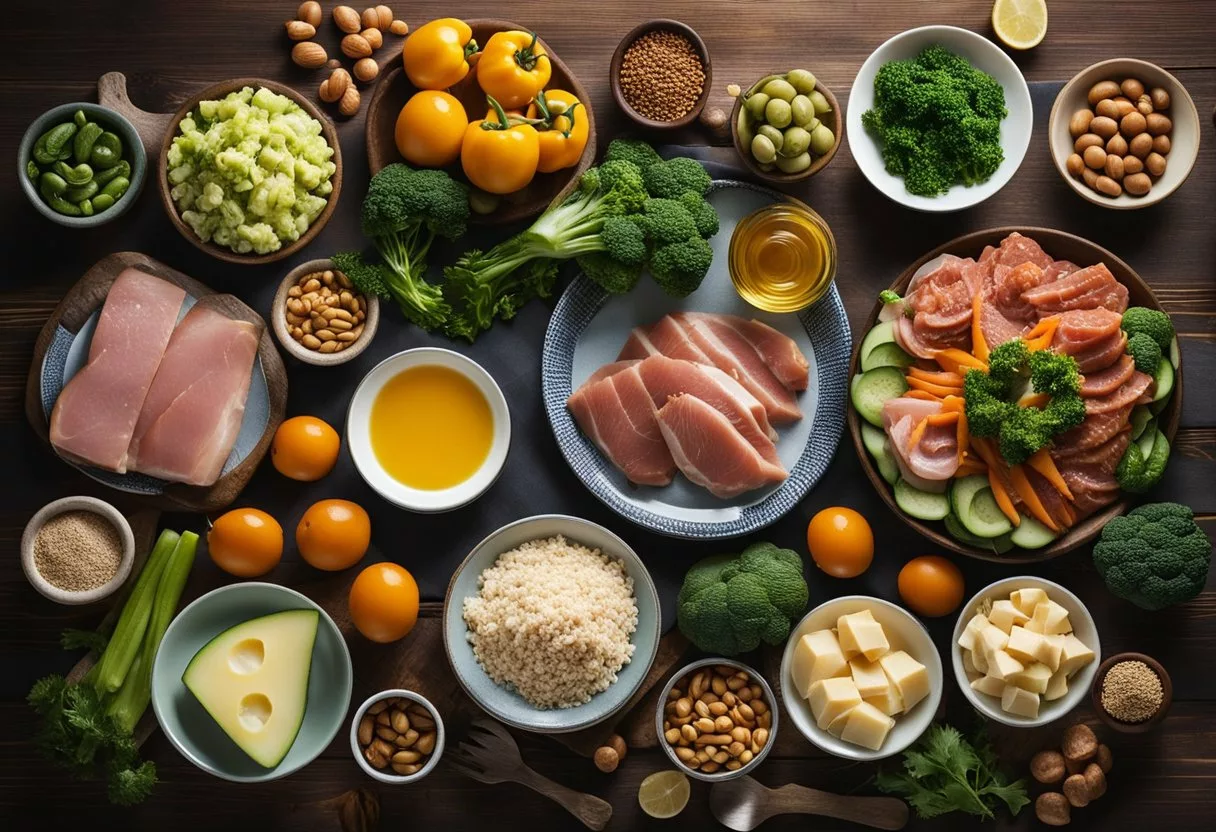
Keto diet is centered around inducing ketosis, a metabolic state where the body burns fat for fuel instead of carbohydrates, potentially leading to weight loss and health benefits.
Basics of Ketosis
Ketosis occurs when carbohydrate intake is drastically reduced, prompting the liver to produce ketones from fats. These ketones then serve as an alternative energy source for the body. Achieving ketosis requires maintaining net carbs typically below 50 grams per day, although some ketogenic diets recommend as little as 20 grams.
Benefits of Keto Diet
The ketogenic diet has been associated with weight loss, improved blood sugar regulation, and a reduction in risk factors for type 2 diabetes. Some individuals experience enhanced energy levels and a decrease in blood pressure.
Risks and Considerations
As with any diet, there are potential risks, such as nutrient deficiencies, liver strain due to increased fat metabolism, and complications with existing medications for diabetes and high blood pressure. It is typically not recommended for individuals who are pregnant, breastfeeding, or have certain metabolic disorders.
The Role of Macronutrients
On a ketogenic diet, macronutrients are distributed as follows: high fat (about 70-80% of calories), moderate protein (around 20-25%), and very low carbs (approximately 5%). This distribution helps maintain ketosis and spurs fat burning.
Keto vs. Other Diets
Keto differs from other low-calorie or low-fat diets by its specific macronutrient ratio, designed to keep the body in a state of ketosis. This contrasts with diets like the Mayo Clinic Diet, which focuses on a wider variety of foods and a balance of macronutrients.
Setting Realistic Goals
Keto can be effective for weight loss, but goals should be realistic, personalized, and include a long-term plan for weight maintenance. It’s recommended to seek guidance from a healthcare provider or a registered dietitian when setting targets for weight loss and overall health.
Planning Your Keto Meals
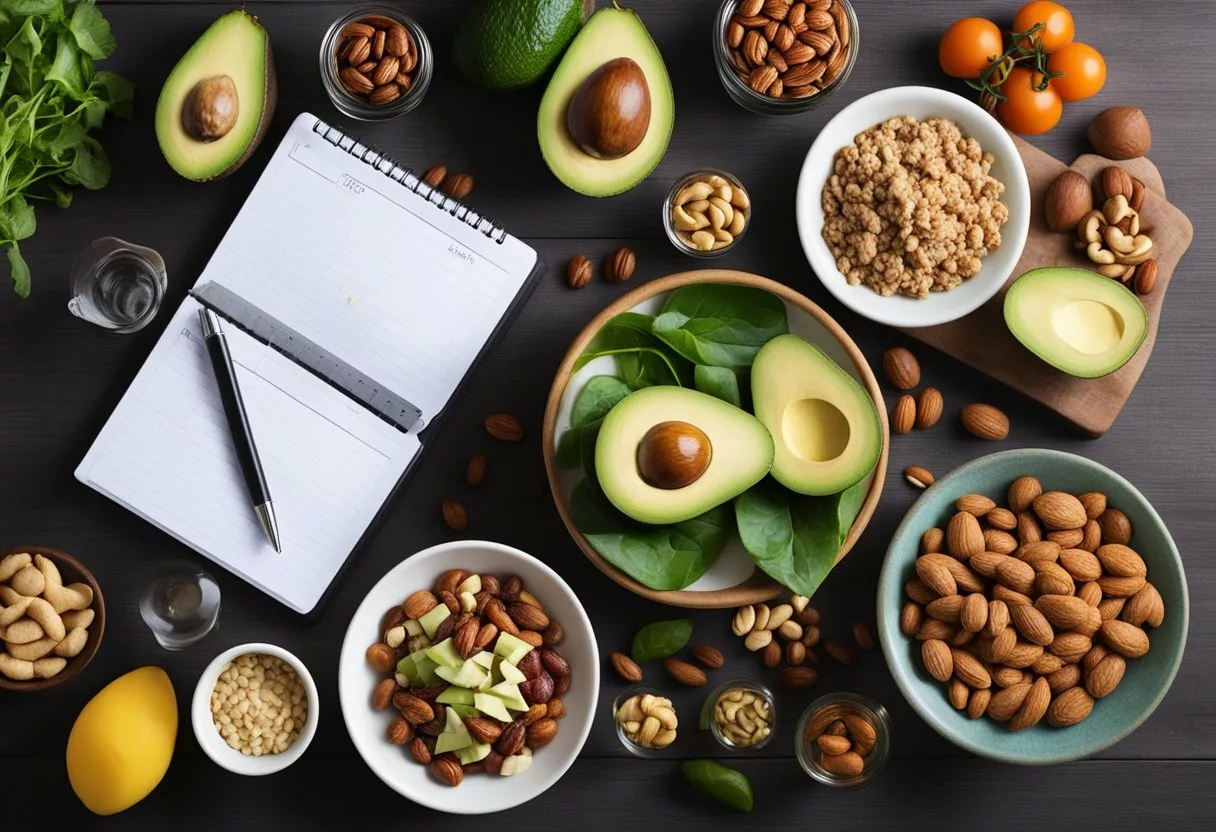
Successful keto meal planning for weight loss involves selecting the right balance of macronutrients and being mindful of what to include and what to exclude from your diet. It’s crucial to plan ahead to maintain ketosis and achieve your goals.
Creating a Keto Meal Plan
A weekly meal plan should balance fats, proteins, and low carbohydrates. Those on a keto diet typically aim for less than 50 grams of net carbs per day. A meal plan might include a fatty fish dinner, a lunch of leafy greens with olive oil, and a cheese and egg breakfast.
Keto-Friendly Foods
Keto-friendly foods are rich in fats and low in carbohydrates. Examples include:
- Fats and Oils: Olive oil, coconut oil, butter, and avocado oil.
- Protein: Meat, poultry, fatty fish, and eggs.
- Low-Carb Vegetables: Leafy greens and other non-starchy vegetables like broccoli and cauliflower.
- Nuts and Seeds: Almonds, walnuts, flaxseeds, and chia seeds.
- Dairy: Cheese, cream, and butter. For those who do not consume dairy, alternatives like coconut cream can be used.
Foods to Avoid on Keto
Certain foods can disrupt the state of ketosis and should be avoided, including:
- High-Carbohydrate Foods: Bread, pasta, rice, and grains.
- Sugary Foods: Baked goods and foods with added sugar.
- Starchy Vegetables: Potatoes, carrots, and other root vegetables.
- Alcohol: Especially beer and sweetened cocktails.
Importance of Meal Timing
On a keto diet, it is not only about what you eat but also when you eat. Consuming your meals at regular intervals can help manage hunger and sustain energy levels. Some individuals might prefer a traditional breakfast, lunch, and dinner structure, while others may opt for intermittent fasting.
Adapting Meals for Dietary Restrictions
Customizing a keto menu can accommodate various dietary restrictions:
- Dairy-Free: Opt for dairy alternatives like almond milk or coconut cream.
- Vegetarian/Vegan: Focus on plant-based proteins, such as tempeh or nuts, and fats from avocados.
- Customization: Adjust the meal plan to avoid allergens or foods that do not meet personal dietary needs.
Hydration and Keto
Staying hydrated is essential, especially on a keto diet where the body can lose more water than usual. Drink plenty of water and include beverages such as coffee or tea, ensuring they do not contain added sugars or high-carb milk.
Recipes and Cooking Tips
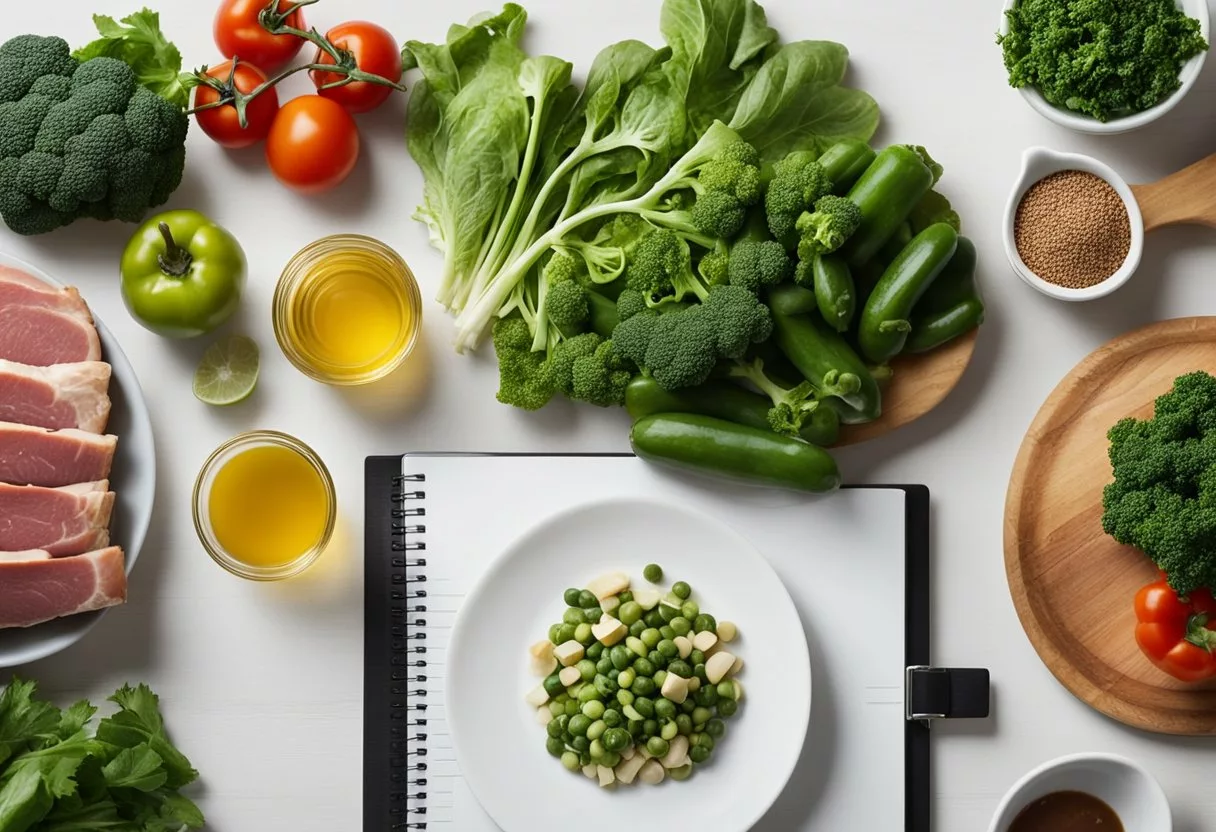
Crafting a successful keto meal plan for weight loss hinges on incorporating a variety of recipes that abide by the low-carb, high-fat principles of the ketogenic diet. Cooking tips designed for keto can help maintain both taste and nutritional value.
Breakfast Ideas
For breakfast, eggs are a mainstay in the ketogenic diet due to their versatility and favorable nutrient profile. A simple recipe might be scrambled eggs with spinach and cheese, ensuring a hearty intake of healthy fats and protein. Another choice is a keto-friendly omelet incorporating avocados—an excellent source of monounsaturated fats.
Lunch Selections
Lunch on keto can include salads with tuna or chicken for protein, mixed with a variety of low-carb vegetables like spinach or kale. Additives like olive oil and vinegar can enhance flavor without increasing carb counts. Cheese can be added for healthy fats and additional flavor.
Dinner Specialties
Dinner recipes often feature fatty fish like salmon or sardines, or various cuts of meat partnered with green beans or broccoli. These meals are typically rich in omega-3 fatty acids and other essential nutrients. A side of sautéed green beans cooked with garlic in olive oil complements the main dish with taste and texture.
Snack Options
For snacks, options are plentiful with nuts like almonds and macadamias, seeds such as pumpkin or sunflower, and small portions of berries. Cheese cubes or slices can also serve as a quick, satisfying keto snack.
Preparing Keto Meals
Effective meal prep involves cooking larger quantities of dishes to save time throughout the week. For instance, grilling several chicken breasts at once allows for easy grabbing-and-going. Low and slow cooking methods, like using a slow cooker for pulled meats, can also preserve nutrients and enhance flavor.
Substituting Common Ingredients
When baking, almond flour or coconut flour can replace traditional flour to keep carbs low. Sweeteners like stevia or erythritol are used in place of sugar to keep recipes keto-friendly. Using these substitutions requires careful measurement, as they have different consistencies and sweetness levels compared to their high-carb counterparts.
Keto Meal Implementation
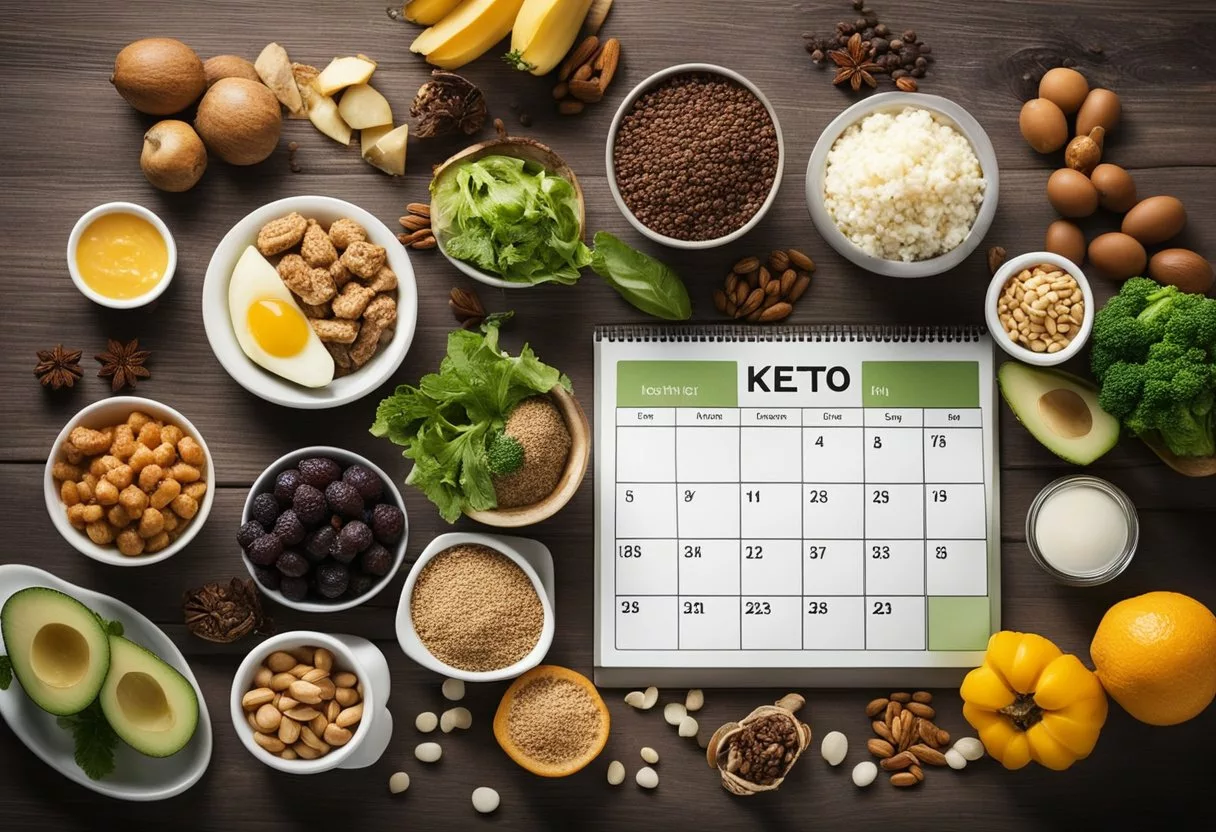
Implementing a keto meal plan for weight loss requires strategic planning both at home and during social situations. It involves managing the initial phase known as the keto flu, consistently tracking progress, and making necessary adjustments to overcome plateaus.
Eating Out and Social Events
When attending social events or eating out, individuals should plan ahead by reviewing the menu and choosing restaurant options that offer ketogenic-friendly choices. Opting for meals high in fats with moderate protein and low in carbohydrates can help maintain ketosis. Restaurant Choices: Grilled meats, leafy green salads with high-fat dressings, and vegetable sides without added sugars or starches align with a ketogenic lifestyle.
Dealing with Keto Flu
The transition into ketosis may trigger the keto flu, characterized by symptoms like fatigue, headaches, and irritability due to electrolyte imbalances. Symptom Management: Increasing intake of electrolytes such as sodium, potassium, and magnesium can alleviate symptoms. Consistent hydration and a balanced meal plan including bone broth or supplementing with electrolyte tablets can be beneficial.
Tracking Progress and Adjustments
They can track their progress using tools such as progress photos, weight measurements, and monitoring ketone levels. Adherence to a meal plan is key, but adjustments may be required if weight loss stalls. Macros: Regularly tracking the intake of macronutrients ensures that one’s diet consists of roughly 75% fat, 20% protein, and 5% carbohydrates, and helps identify if caloric adjustments are necessary.
Addressing Plateaus
Weight loss plateaus are common and can be addressed by reassessing one’s caloric needs, possibly incorporating exercise to increase energy expenditure, or tweaking the meal plan for greater macro precision. Ketogenic Plateau: They may need to temporarily reduce caloric intake or adjust the ratio of fats, proteins, and carbohydrates to re-establish the state of ketosis and resume weight management.
Shopping and Meal Preparation
Successful keto meal planning hinges on a well-thought-out shopping list and efficient meal preparation. Knowing what to buy and how to prepare meals is crucial for maintaining ketosis.
Keto Grocery List
A strategic keto grocery list should include:
- Fats: Extra virgin olive oil, coconut oil, and avocado oil.
- Proteins: Eggs, poultry, fish, and cuts of meat high in fat.
- Dairy: Full-fat cheeses, heavy cream, and butter.
- Nuts and Seeds: Almonds, walnuts, chia seeds.
- Vegetables: Leafy greens, broccoli, and cauliflower.
- Fruits: A modest amount of berries due to their lower carb content.
- Others: Olives, dark chocolate (above 70% cocoa), and unsweetened coffee and tea.
Budget-Friendly Shopping
- Bulk Buying: Purchase items like nuts, olive oil, and meats in bulk to save money.
- Cost-Saving Tips: Choose in-season vegetables and berries, and buy store-brand cheese and cream to reduce costs.
Meal Prepping Strategies
- Batch Cooking: Cook meals in larger quantities to save time and ensure consistency in dietary intake.
- Time Management: Allocate specific days for meal prep, and divide tasks into manageable segments.
Keto-Friendly Kitchen Setup
- Storage Solutions: Invest in quality containers for storing prepped meals.
- Cooking Tools: Have a set of reliable utensils, pans, and pots to ease the cooking process.
Understanding Food Labels
- Ingredient List: Check for hidden carbs and sugars; the fewer the ingredients, the better.
- Nutrition Labels: Look for net carbs (total carbohydrates minus fiber) and serving size to remain in ketosis.
Long-Term Success on Keto
Transitioning to a keto lifestyle for weight loss requires dedication and a well-thought-out plan. Here we explore strategies to maintain this lifestyle successfully, address typical challenges, and review the role of community, adaptation, and evaluation in achieving long-term health goals.
Sustaining a Keto Lifestyle
A keto lifestyle is underpinned by consistent lifestyle changes and long-term planning. Individuals often need to make significant adjustments in their diet, focusing on high fat, moderate protein, and low carbohydrate foods. The maintenance phase is crucial; it is not merely temporary dieting but adopting new eating habits for life. To sustain this, they:
- Maintain a balance of macronutrients to stay in ketosis
- Introduce variety and creativity in meal preparation to avoid monotony
- Regularly update their meal plans based on their changing needs and preferences
Overcoming Challenges
The journey through the keto diet often presents common obstacles such as managing cravings, dealing with peer pressure, and maintaining energy levels. To overcome these challenges individuals might:
- Plan ahead for social events to navigate dietary restrictions
- Keep keto-friendly snacks handy to combat cravings
- Monitor their body composition and mental clarity to stay motivated
The Importance of Community
Support groups, forums, and keto communities offer a wealth of inspiration and practical advice for individuals adhering to a keto lifestyle. Being a part of a community helps them:
- Share experiences and tips on tackling common obstacles
- Gain emotional support which is an integral part of health monitoring and well-being
- Stay up-to-date with latest findings and research on keto living
Continual Learning and Adaptation
As the body adapts to a ketogenic diet, individuals may need to adjust their approach. Continual learning about:
- Nutrition studies to refine their meal strategies
- Incorporate latest findings to fine-tune their diet for optimal health
- Be open to changing meal plans according to their health monitoring feedback, including blood work and energy levels
Evaluating Health Improvements
Regular health monitoring, including periodic blood work, helps individuals track the impact of the keto diet on their health. They may notice improvements in:
- Energy levels and mental clarity
- Body composition changes, such as reduced body fat percentage
- Blood markers related to cholesterol and blood sugar levels
By focusing on these areas, individuals can make informed decisions about continuing or adjusting their keto lifestyle for sustained health benefits.
Customizing Your Keto Plan
Tailoring a ketogenic diet to one’s individual lifestyle, health goals, and nutritional needs is crucial for ensuring long-term adherence and maximum benefits. The following subsections provide guidance on adjusting macronutrient ratios, incorporating supplements, aligning the diet with fitness objectives, adapting to various life stages, and utilizing technology for an optimized keto diet plan.
Personalizing Macronutrient Ratios
Every individual’s body responds differently to dietary changes, so customizing macronutrient breakdown is essential to achieving health objectives. The standard keto diet typically consists of approximately 70-75% fat, 20-25% protein, and 5-10% carbohydrates. Depending on one’s metabolism and activity level, these ratios can be modified to maintain ketosis—a metabolic state where the body burns fat for fuel instead of carbs. For instance, someone with a higher metabolism may require a slightly higher carb intake, while staying within the ketogenic framework.
Integrating Supplements
To complement the keto diet and ensure adequate nutrient intake, certain supplements might be beneficial:
- Electrolytes: Sodium, potassium, and magnesium are important to prevent the “keto flu.”
- Multivitamins: A quality multivitamin can cover any nutritional gaps, especially for micronutrients harder to obtain in a keto diet.
- Omega-3s: These support heart health and can be found in fish oil or algae-based supplements.
Modifying for Fitness Goals
Exercise performance and muscle gain require careful dietary planning while on keto. For active individuals, the diet can be adjusted to provide more calories and protein for muscle repair and growth, while still limiting carbs. Post-workout nutrition should focus on these aspects without compromising ketosis. Bodybuilders or high-performance athletes may explore targeted or cyclical keto diets that allow for higher carb intake during specific times to replenish glycogen stores.
Keto for Different Life Stages
A keto diet can be adapted for various life stages with distinct nutritional requirements:
- Pregnancy: Emphasis on nutrient-dense foods to support fetal development, with medical guidance.
- Senior Health: A focus on maintaining muscle mass and bone health through adequate protein and calcium-rich foods. Each stage may necessitate tailored adjustments to carb and fat ratios as well as overall caloric intake.
Using Technology to Enhance Keto
Technology can streamline the keto diet process and assist with customization:
- Mobile Apps: Tools for tracking daily macronutrient intake, hydration levels, and progress toward health objectives.
- Tracking Platforms: Websites or apps that offer personalized meal planning and community support through online forums. These technological aids can provide real-time feedback, making it easier to stay on track with a keto lifestyle.
Frequently Asked Questions
In this section, we address some of the most common queries around ketogenic meal planning for weight loss, guiding beginners and seniors alike through essential shopping lists, straightforward meal plans, quick recipes, long-term diet strategy, and meal prep frequency.
What basic foods should be included on a healthy ketogenic shopping list?
A ketogenic shopping list should prioritize low-carb vegetables like spinach and broccoli, high-quality fats such as avocado and olive oil, and proteins including eggs and lean meats. Cheese, nuts, and seeds are also keto staples for their fat content and minimal carbs.
Can you provide a simple ketogenic diet plan suitable for beginners?
A simplified ketogenic diet plan for beginners might consist of a breakfast with eggs and spinach, a lunch with grilled chicken salad, an afternoon snack of almonds, and a dinner featuring salmon with asparagus. This pattern offers a balance of fats, proteins, and low-carb vegetables.
What are some quick and easy keto recipes for beginners?
Beginners can opt for recipes like avocado egg bowls for breakfast, tuna salad lettuce wraps for lunch, and zucchini noodles with creamy pesto for dinner. These dishes are not only quick to prepare but also align with keto macros and are flavorful.
How can one plan a keto diet for sustained weight loss over a month?
For a month-long keto diet plan, variety and nutritional balance are key. Individuals should rotate their meats and vegetables weekly to prevent boredom, keep electrolytes balanced, and ensure adequate fiber intake, all of which contribute to sustained weight loss.
What considerations should seniors have when following a keto diet plan?
Seniors should focus on easy-to-digest proteins, calcium-rich dairy for bone health, and potassium-rich foods to regulate blood pressure. They should also consult healthcare providers to ensure keto aligns with their individual health needs.
How frequently should meals be prepped for an effective keto weight loss journey?
Meal prepping twice a week can help individuals maintain a consistent keto diet, allowing for fresh meals without daily cooking. Prepping in batches ensures portion control and macro consistency, essential for an effective keto weight loss journey.
